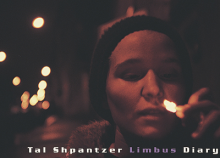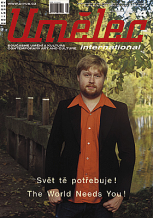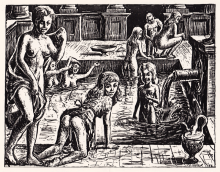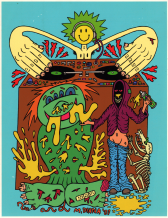| Zeitschrift Umělec 2002/4 >> Island in the bog | Übersicht aller Ausgaben | ||||||||||||
|
|||||||||||||
Island in the bogZeitschrift Umělec 2002/401.04.2002 Jeffrey A. Buehler | galleriy | en cs |
|||||||||||||
|
This issue’s featured gallery is a unique one. Though there is no reason why it should be. At a time when endeavors such as this one should be competing with and operating alongside the more seasoned noncommercial galleries that grew out of the 90s experience, new HOME gallery finds itself in prime position. The fledgling space stands nearly alone on the moneyless, muddy flood-ravaged slopes of Prague.
HOME Gallery is boldly entering the art fray in the Czech Republic at a time when any new contemporary art initiative suddenly carries the responsibility of providing a future for the visual arts. And that only with the always uncertain support of the State. But there is hope. Several factors make this space promising, including the physical dimensions, its tangible qualities of light and space, and the personalities in charge. With some trepidation I questioned the two women artists behind the project, about their plans for bringing the gallery to life and giving it solid legs to stand on. As with any measure of guarded hope that goes along with a potentially good idea, there is also a fair dose of reluctance and suspicion to balance things out. The fate of too many galleries here in the recent past has kept expectations very real and grounded. And, as it turns out, there are ideas. Veronika Drahotová, artist and spearhead of the whole business, describes a magical money “trinity” to float the gallery, at least in its early days: money from sales (yes, they seriously plan to sell the art they show), money from a general partner (yet unknown), and money from the State. As is the case for most initiatives of this sort in the Czech Republic, the last third of the trinity is the most crucial for staying alive and being vital. “With this money we can survive for the first half of the year,” Drahotová explains one cold gray afternoon in the gallery office, where we drink fruit tea and huddle over the space heater to keep warm. “And that’s only for the gallery expenses. That doesn’t even include launching the exhibitions.” The gallery itself measures in at 180 square meters and is rectangular in shape with a lofty ceiling and two regular rows of sunken cubic skylights. The one-room gallery has a clean garage feeling, an open light space with a gritty quality. Its location in the heart of the city and, more specifically, its position set back from the street between two taller residential buildings, make it both accessible and intimate. No wonder it’s called HOME. The result of this was obvious at the gallery opening when, after the standard consumption of bread wedges with various creamy toppings and red and white wine in plastic cups, the normally cagey art crowd began cutting up the floor in the center of the room to scratchy punk and disco records. The art on the walls or floor is not forgotten in some out of the way rooms or languishing under bad lighting with ugly carpet. It is present and clearly seen, even during openings. Veronika Bromouvá, the other half of the duo, makes it clear why she wants to do a gallery despite the fact that she already has a full plate being a multimedia artist and head instructor of the New Media II studio at Prague’s Academy of Fine Arts. “What was open at the beginning of the 90s is not so open now,” Bromouvá says. “There is a bad feeling here, and we would like to work against this.” She envisions this also on a larger scale. One of the missions of the gallery will be to work beyond the borders of the country. Though the program for the first year is not entirely ironed out yet, they plan to have an international selection of artists. The gallery will create conceptual exhibitions that will include artists from this country and artists from abroad. One of the more interesting longterm goals of the gallery will be to form an international inter-linked web of like-minded galleries called HOMEnet, which will pass along quality shows, possibly for years at a time. Using the experience and connections the two artists have accumulated over the years some effort is already being made in this direction. “The time is different now,” Bromouvá says. “It’s no longer possible to sit in your apartment and do your work. It’s a change of mind, when you stop working for yourself and you begin working for others.” HOME Gallery opened its doors on 13 December 2002 with an exhibition of the Slovenian art group IRWIN. The one long room of the gallery space was packed with art opening regulars. The atmosphere was festive and alive; journalists and business tycoons mingled with young artists. The performance scourge Obludarium (Freak Show) did what they always do (and they have yet to be forgiven). All in all, a measure of hope flickered here. It remains to be seen if, with the combination of State money, savvy, and a whole lot of luck, HOME can find its place in the local and international scene. We wish them the best.
01.04.2002
Empfohlene Artikel
|
|||||||||||||
|
04.02.2020 10:17
Letošní 50. ročník Art Basel přilákal celkem 93 000 návštěvníků a sběratelů z 80 zemí světa. 290 prémiových galerií představilo umělecká díla od počátku 20. století až po současnost. Hlavní sektor přehlídky, tradičně v prvním patře výstavního prostoru, představil 232 předních galerií z celého světa nabízející umění nejvyšší kvality. Veletrh ukázal vzestupný trend prodeje prostřednictvím galerií jak soukromým sbírkám, tak i institucím. Kromě hlavního veletrhu stály za návštěvu i ty přidružené: Volta, Liste a Photo Basel, k tomu doprovodné programy a výstavy v místních institucích, které kvalitou daleko přesahují hranice města tj. Kunsthalle Basel, Kunstmuseum, Tinguely muzeum nebo Fondation Beyeler.
|


































 We Are Rising National Gallery For You! Go to Kyjov by Krásná Lípa no.37.
We Are Rising National Gallery For You! Go to Kyjov by Krásná Lípa no.37.
Kommentar
Der Artikel ist bisher nicht kommentiert wordenNeuen Kommentar einfügen